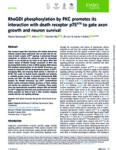Diabetologia has now published online our latest paper describing differential actions of activins A and B and Smad proteins 2 and 3 on the regulation of insulin secretion by pancreatic beta cells (Wu et al., 2013).
Glucose-stimulated insulin secretion (GSIS) from pancreatic beta-cells is regulated by paracrine factors whose identity and mechanisms of action are incompletely understood. Activins are expressed in pancreatic islets and have been implicated in the regulation of GSIS. Activins A and B signal through a common set of intracellular components, but it is unclear whether they display similar or distinct functions in glucose homeostasis. Glucose homeostatic responses were examined in mice lacking activin B and in pancreatic islets derived from these mutants. The ability of activins A and B to regulate downstream signalling, ATP production and GSIS in islets and in beta-cells was compared. Mice lacking activin-B displayed elevated serum insulin levels and glucose-stimulated insulin release. Injection of a soluble activin B antagonist phenocopied these changes in wild type mice. Isolated pancreatic islets from mutant mice showed enhanced GSIS which could be rescued by exogenous activin B. Activin B negatively regulated GSIS and ATP production in wild type islets, while activin-A displayed opposite effects. The downstream mediator Smad3 responded preferentially to activin B in pancreatic islets and beta-cells, while Smad2 showed preference for activin A, indicating distinct signalling effects of the two activins. In line with this, overexpression of Smad3, but not Smad2, decreased GSIS in pancreatic islets. These results reveal a tug-of-war between activin ligands in the regulation of insulin secretion by beta-cells and suggest that manipulation of activin signalling could be a useful strategy for the control of glucose homeostasis in diabetes and metabolic disease.
Read the full article HERE.



Leave a Reply